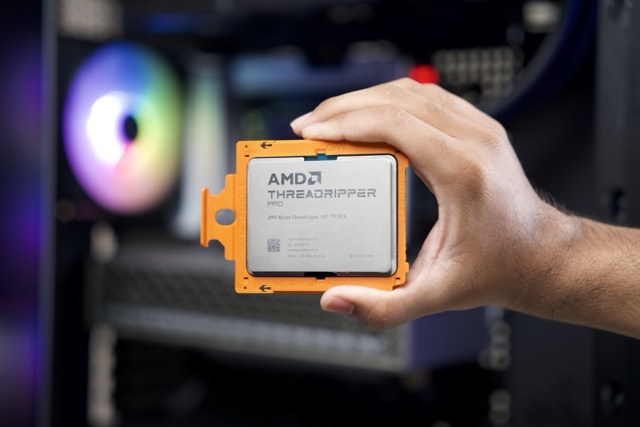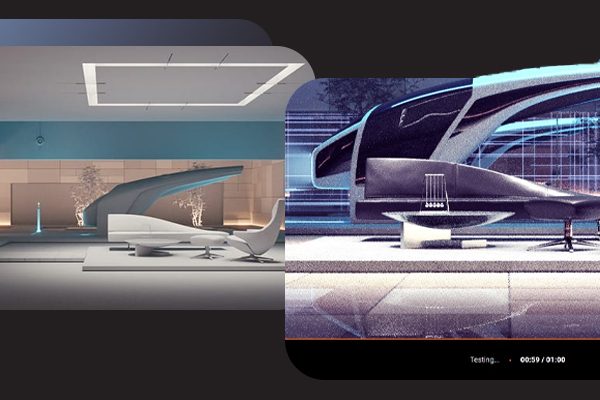We just finished assembling a workstation around AMD’s latest Threadripper 9975WX, and it got us thinking about something we don’t talk about enough : pure CPU horsepower still counts for a lot. Sure, everyone’s fixated on GPUs and AI accelerators these days, but Threadrippers occupy a niche that nothing else really fills.
Here’s why that matters.
The Architecture
Threadripper has never been just about cramming in more cores. What really distinguishes it is the platform itself : the motherboard design and I/O infrastructure.
Your typical mainstream CPU gives you somewhere between 20 and 24 PCIe lanes. On the other hand, Threadripper platforms like TRX50 and WRX90 give you 80 to 128 PCIe 5.0 lanes, along with quad- or octa-channel memory configurations.
Sounds excessive until you realize what becomes possible. You can run multiple GPUs at their full bandwidth. Build out high-speed NVMe RAID arrays. Stack capture cards, network adapters, and accelerators multiple 8k camera inputs : everything running simultaneously at full speed without choking each other for resources.
This isn’t something you can jugaad with splitters or clever PCIe bifurcation on consumer boards. The Threadripper motherboard ecosystem was designed from the ground up for parallel workflows, not home gaming setups. Studios, simulation labs, and broadcast facilities still lean on these systems for exactly that reason.
So why not just render everything on the GPU?
Short answer = not if you need accuracy, consistency, and robust memory handling.
GPUs excel at throwing massive parallelism at a problem, but CPUs are better when precision and data integrity can’t be compromised. Whether you’re calculating turbulence patterns, running financial models, or simulating physical impacts, getting the right answer matters more than getting an answer quickly.
A GPU might churn through thousands of threads, but a CPU makes sure each one of them is correct.
Real-World Applications
1) Architecture, Design & Visualization
Picture a large architecture firm working with BIM (Building Information Modeling). You’ve got different teams handling structural elements, electrical systems, interiors, and mechanical components. Eventually, all of that gets merged into one massive unified model.
Rendering or simulating that final model can drag on for hours on a standard desktop. On a many-core Threadripper workstation? You’re done in minutes.
The efficient approach looks like this: each designer works on their regular PC for modeling tasks. When they’re ready, files get pushed to a shared Threadripper render node. That machine handles the computationally intensive work while everyone else keeps designing.
This isn’t about flashy hardware. It’s about structuring workflows so teams get more done faster, without needing to buy expensive machines for every desk.
2) Quantitative Trading
In algorithmic trading, milliseconds translate directly to millions of dollars.
Traders aren’t making gut calls, they’re analyzing market data streams and running mathematical models that dictate buy and sell decisions thousands of times per day. In this environment, precision means everything. CPUs process calculations deterministically. GPUs don’t offer that same guarantee.
That’s exactly why high-frequency trading infrastructure depends on CPU horsepower. We’ve assembled 96-core systems for clients in this field, where computational accuracy can be the difference between profit and loss.
3) Broadcasting at Scale
Take something like an IPL cricket match. You’ve got multiple camera feeds: main coverage, stump cams, Spidercam which are all sending uncompressed 4K video in real time.
Processing all of that simultaneously means every stream gets captured, encoded, and transmitted live. GPUs handle the encoding work, but the data has to reach them without hitting bottlenecks.
That’s where systems with 128 PCIe lanes prove their worth. The CPU becomes a traffic controller, ensuring every capture card, GPU, and SSD operates at full speed with no latency. We’ve seen this first hand : the systems we built for IPL broadcasting handled that load without breaking a sweat.
4) Formula 1
Formula 1 teams don’t rely solely on track testing; they simulate airflow across the car’s body using Computational Fluid Dynamics.
Each simulation solves billions of equations representing air pressure, drag coefficients, and turbulence behavior. If your memory bandwidth can’t feed data quickly enough, your cores just sit there waiting.
That’s why applications like ANSYS Fluent thrive on Threadripper’s octa-channel memory, it keeps all those cores fed with data, speeding up solver convergence and shrinking simulation times.
In racing, that translates to quicker feedback loops, more design iterations, and ultimately a faster car; sometimes by fractions of a second, which is all it takes to separate first place from second.
5) Automotive Safety
Before any vehicle reaches production, it gets virtually crashed thousands of times. Software like LS-DYNA simulates the complete physics of a collision; every fastener, weld point, and material deformation, calculated down to microsecond intervals.
A simulation that might take days on a standard CPU wraps up overnight on a 96-core Threadripper. With eight memory channels, every core gets the data stream it needs without waiting.
That speed enables more iterations, more thorough testing, and in the end, safer vehicles on the road.
6) Creative Studios & 8K Workflows
High-end production houses working with 8K RAW footage or intraframe codecs lean heavily on CPU performance. Unlike compressed codecs, RAW formats don’t gain much from GPU acceleration.
For editors, VFX artists, or colorists managing enormous files, Threadripper’s bandwidth and I/O capacity translate to smoother timeline playback, faster transcoding, and less time staring at loading bars.

Threadrippers aren’t for everyone, but if your work depends on parallel processing, multi-device workflows, or computational accuracy at scale, they’re still the best tool for the job.
We build custom Threadripper workstations tailored to exactly what you need. Whether you’re running simulations, processing broadcast feeds, or managing massive creative projects, we’ll configure a system that fits your workflow (not just throw specs at you).
Check out our workstation builds on our website and see what’s possible when you match the right hardware to the right problem.






